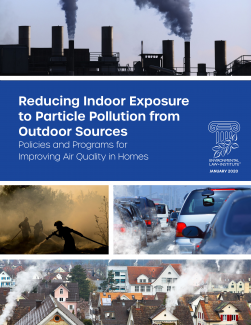
Particulate matter (PM) is an air pollutant that has been linked to a wide range of serious health effects, including cardiovascular and respiratory symptoms and disease, as well as neurological and endocrine disorders.
Exposure to particulate matter generated outside occurs largely indoors since, on average, people in the U.S. spend most of their time inside buildings. Particles in outdoor air can enter buildings through cracks and gaps in the building envelope and through natural or mechanical ventilation. Fortunately, there are evidence-based technical solutions that can help reduce indoor PM exposure, including reducing infiltration of outdoor air and ensuring adequate filtration of the air that enters buildings and that recirculates indoors.
This report highlights opportunities for states, tribes, and local governments to implement well-established practices for reducing exposure to PM from outdoor sources and creating healthier, more resilient buildings. Other ELI materials address indoor PM sources such as cooking and wood burning.
Overview of the Report
States, tribes, and local governments have an important role to play in advancing building design, construction, operation, and maintenance practices that promote healthy buildings. Many jurisdictions already have policy and program frameworks that can be strengthened and implemented to reduce indoor PM exposure. The report highlights examples of policies addressing the problem in both new construction and existing homes.
Reducing PM Exposure in New Residential Construction. There are a number of ways that policy makers can advance high-efficiency filtration and related practices in new residential construction. Many state and local governments have adopted building codes that set minimum standards for new home construction and renovation. Yet most of these building codes – and the model codes and standards upon which they are based – do not require high-efficiency filtration. The report describes a notable exception – California’s 2019 building code revision that included a high efficiency (MERV 13) filtration requirement. (Washington state followed suit in 2023.) Other policy approaches include incorporating high efficiency filtration into green building policies that go beyond minimum code standards and establishing land use planning policies that require building setbacks, air filtration, and other design features for projects located near air pollution sources such as high-volume roads.
Reducing PM Exposure in Existing Homes. States, tribes, and local governments establish housing codes, landlord-tenant laws, nuisance laws, and other policies to address indoor environmental quality conditions in housing. Housing codes, the primary regulatory vehicle for setting minimum habitability standards in rental properties, need to be strengthened to include specific provisions addressing air filtration and filter replacement. Requirements for safe indoor temperatures are also important so that tenants can close their windows during periods of unhealthy air quality and reduce the risk of heat-related illness.
Financial and In-Kind Assistance Programs. Funding programs are vital for assisting households that are at high risk for exposure to particulate matter and that lack financial resources to take steps to reduce indoor exposure. Some federally-funded programs that are already in place in many jurisdictions could be adapted for this purpose. Programs funded by states, tribes, and local governments to provide home repairs and improvements could also be leveraged to incorporate air filtration and other measures to reduce indoor air exposures.
Explore other materials from ELI’s Indoor Environments Program.
© Environmental Law Institute®